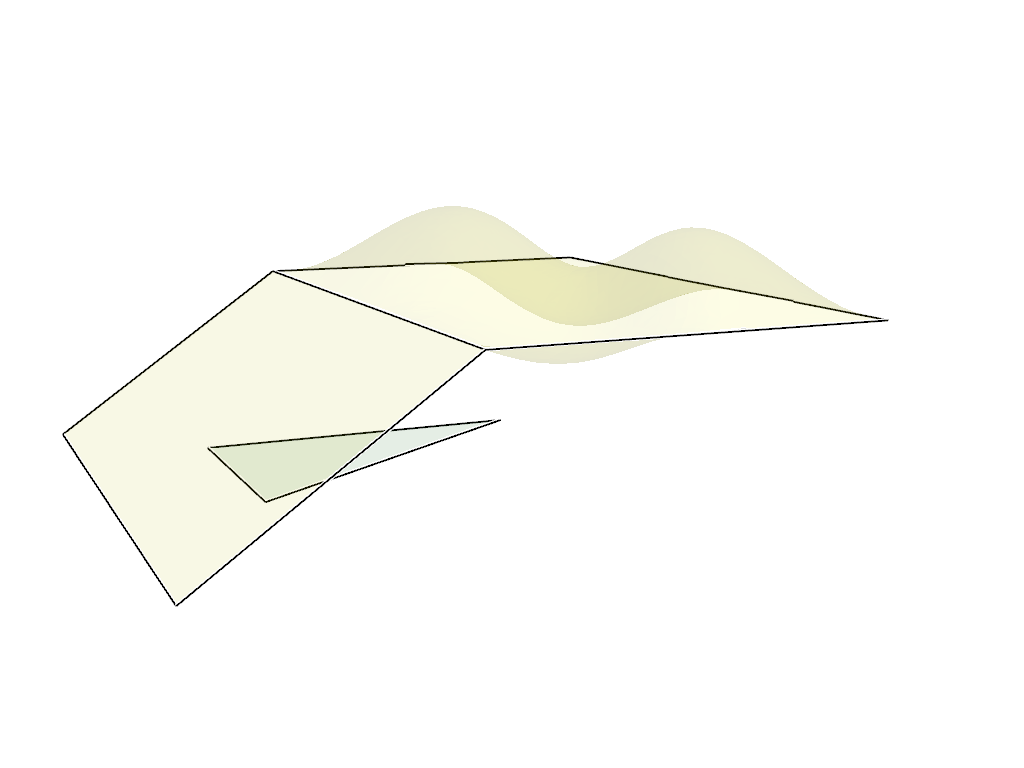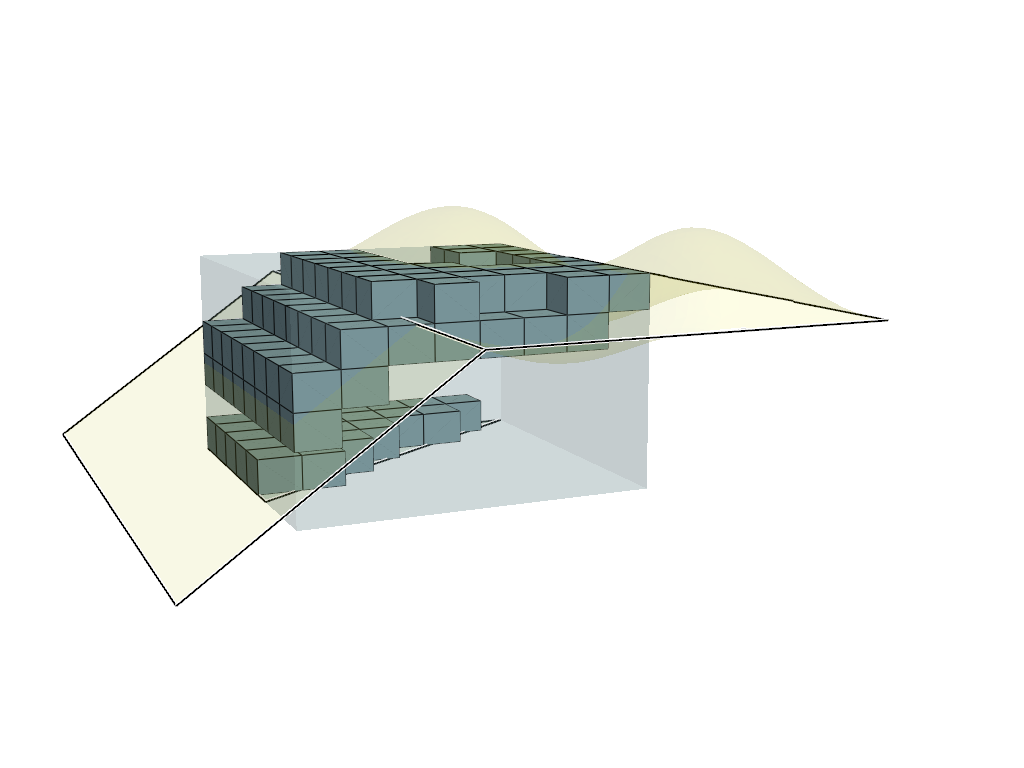Note
Go to the end to download the full example code.
Imported ply#
The definition and use of imported plies is demonstrated in this example.
In a nutshell, the difference between ImportedModelingPly and
ModelingPly is that the surface mesh of an ImportedModelingPly
is defined by an external source, such as a CAD surface, where a ModelingPly
is always defined on the initial loaded shell mesh.
Therefore, an imported ply can only be used in combination with an
ImportedSolidModel.
This examples shows hot to:
Load an initial mesh
Import geometries which will be used to define the surface of the
ImportedModelingPlyAdd two imported modeling plies
Create an
ImportedSolidModelMap the imported plies to the solid model
Visualized the mapped plies.
Import modules#
Import the standard library and third-party dependencies.
import os
import pathlib
import tempfile
import pyvista
Import the PyACP dependencies.
from ansys.acp.core import CADGeometry, ImportedPlyOffsetType, PlyType, VirtualGeometry, launch_acp
from ansys.acp.core.extras import ExampleKeys, get_example_file
from ansys.acp.core.material_property_sets import ConstantDensity, ConstantEngineeringConstants
CAMERA_POSITION = [(0.0436, 0.0102, 0.0193), (0.0111, 0.0035, 0.0046), (-0.1685, 0.9827, -0.0773)]
Start ACP and load the model#
Get the example file from the server.
tempdir = tempfile.TemporaryDirectory()
WORKING_DIR = pathlib.Path(tempdir.name)
input_file = get_example_file(ExampleKeys.BASIC_FLAT_PLATE_DAT, WORKING_DIR)
Launch the PyACP server and connect to it.
acp = launch_acp()
Create a model by loading a shell mesh
model = acp.import_model(path=input_file, format="ansys:dat")
Add a material and a fabric with 1mm thickness. The fabric is used for the imported modeling ply.
engineering_constants_ud = ConstantEngineeringConstants.from_orthotropic_constants(
E1=5e10, E2=1e10, E3=1e10, nu12=0.28, nu13=0.28, nu23=0.3, G12=5e9, G23=4e9, G31=4e9
)
density_ud = ConstantDensity(rho=2700)
ud_material = model.create_material(
name="E-Glass UD",
ply_type=PlyType.REGULAR,
engineering_constants=engineering_constants_ud,
density=density_ud,
)
engineering_resin = ConstantEngineeringConstants.from_isotropic_constants(E=5e9, nu=0.3)
density_resin = ConstantDensity(rho=1200)
void_material = model.create_material(
name="Void material",
ply_type=PlyType.ISOTROPIC,
engineering_constants=engineering_resin,
density=density_resin,
)
filler_material = model.create_material(
name="Filler material",
ply_type=PlyType.ISOTROPIC,
engineering_constants=engineering_resin,
density=density_resin,
)
fabric = model.create_fabric(name="E-Glass Fabric", material=ud_material, thickness=0.001)
Import CAD geometries#
Import two cad surfaces to define the surface of the imported modeling plies.
def create_virtual_geometry_from_file(
example_key: ExampleKeys,
) -> tuple[CADGeometry, VirtualGeometry]:
"""Create a CAD geometry and virtual geometry."""
geometry_file = get_example_file(example_key, WORKING_DIR)
geometry_obj = model.create_cad_geometry()
geometry_obj.refresh(geometry_file) # upload and load the geometry file
model.update()
virtual_geometry = model.create_virtual_geometry(
name=os.path.basename(geometry_file), cad_components=geometry_obj.root_shapes.values()
)
return geometry_obj, virtual_geometry
triangle_surf_cad, triangle_surf_vcad = create_virtual_geometry_from_file(
ExampleKeys.RULE_GEOMETRY_TRIANGLE
)
top_surf_cad, top_surf_vcad = create_virtual_geometry_from_file(ExampleKeys.SNAP_TO_GEOMETRY)
Definition of Imported Plies#
imported_ply_group = model.create_imported_modeling_group(name="Imported Ply Group")
imported_ply_triangle = imported_ply_group.create_imported_modeling_ply(
name="Triangle Ply",
offset_type=ImportedPlyOffsetType.BOTTOM_OFFSET,
ply_material=fabric,
mesh_geometry=triangle_surf_vcad,
ply_angle=0,
rosettes=[model.rosettes["12"]],
)
imported_ply_top = imported_ply_group.create_imported_modeling_ply(
name="Triangle Ply",
offset_type=ImportedPlyOffsetType.MIDDLE_OFFSET,
ply_material=fabric,
mesh_geometry=top_surf_vcad,
ply_angle=45,
rosettes=[model.rosettes["12"]],
)
model.update()
Imported plies cannot be visualized directly yet but the cad geometries are shown here instead. To visualize the imported plies, you can save the model and load it in ACP standalone.
def plotter_with_all_geometries(cad_geometries):
colors = ["green", "yellow", "blue", "red"]
plotter = pyvista.Plotter()
for index, cad in enumerate(cad_geometries):
geom_mesh = cad.visualization_mesh.to_pyvista()
plotter.add_mesh(geom_mesh, color=colors[index], opacity=0.1)
edges = geom_mesh.extract_feature_edges()
plotter.add_mesh(edges, color="white", line_width=4)
plotter.add_mesh(edges, color="black", line_width=2)
plotter.camera_position = CAMERA_POSITION
return plotter
plotter = plotter_with_all_geometries([triangle_surf_cad, top_surf_cad])
plotter.show()

Map Imported Plies onto a solid mesh#
An external solid mesh is loaded now to map the imported plies onto the solid model. The next figure shows the imported solid mesh and the imported plies.
local_solid_mesh_file = get_example_file(ExampleKeys.BASIC_FLAT_PLATE_SOLID_MESH_CDB, WORKING_DIR)
remote_solid_mesh_file = acp.upload_file(local_solid_mesh_file)
imported_solid_model = model.create_imported_solid_model(
name="Imported Solid Model",
external_path=remote_solid_mesh_file,
format="ansys:cdb",
)
imported_solid_model.import_initial_mesh()
plotter = plotter_with_all_geometries([triangle_surf_cad, top_surf_cad])
plotter.add_mesh(imported_solid_model.solid_mesh.to_pyvista(), show_edges=True, opacity=0.5)
plotter.show()

Add a mapping object to link the imported plies with the solid model. In this example, all imported plies are mapped in one go. The remaining elemental volume and elements which do not intersect with the imported plies are filled with a void and filler material, respectively.
imported_solid_model.create_layup_mapping_object(
name="Map imported plies",
use_imported_plies=True, # enable imported plies
select_all_plies=True, # select all plies
entire_solid_mesh=True,
scale_ply_thicknesses=False,
void_material=void_material,
delete_lost_elements=False,
filler_material=filler_material,
rosettes=[model.rosettes["12"]],
)
model.update()
Show the imported ply geometries and mapped plies on the solid model. Note that the analysis plies are not yet directly accessible via the API of the imported solid model. Also, elemental data such as thicknesses are not yet implemented for imported plies.
plotter = plotter_with_all_geometries([triangle_surf_cad, top_surf_cad])
for imported_ply in [imported_ply_triangle, imported_ply_top]:
for pp in imported_ply.imported_production_plies.values():
for ap in pp.imported_analysis_plies.values():
plotter.add_mesh(ap.solid_mesh.to_pyvista(), show_edges=True, opacity=1)
plotter.add_mesh(mesh=imported_solid_model.solid_mesh.to_pyvista(), show_edges=False, opacity=0.2)
plotter.show()

The imported solid model can be passed to Mechanical or MAPDL to run an analysis as shown in the examples PyMechanical solid workflow and PyMAPDL workflow.
Total running time of the script: (0 minutes 6.362 seconds)

